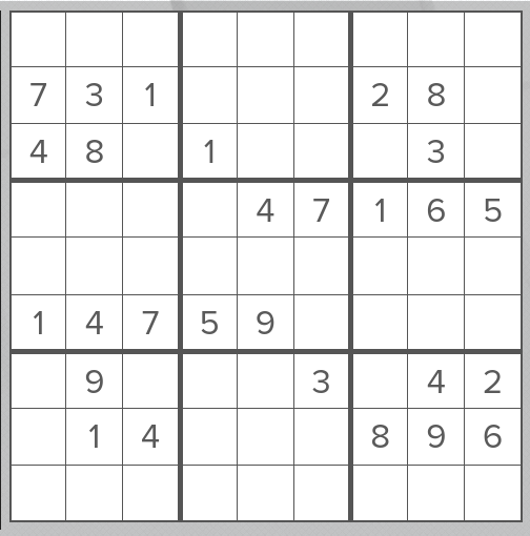This series is designed to help people to understand modern technology, and become more confident in using computing devices. It is not designed to educate experts.
The author is involved in tutoring older students at SeniorNet, a New Zealand wide organisation. SeniorNet hopes that students will feel more confident in using their computing devices as a result of the learning opportunities offered. This series of articles shares that hope.
Your comments, suggestions and questions are welcome in the comment section below.
I am a puzzle buff and get great enjoyment from The BFD puzzles each morning. Mrs Korau, the cat and I sit up in bed and do both the Codecracker and Crossword after the 6:00am news on the radio. We’ve breakfasted by then so it’s time to start the brain for the day. If we can’t come in as No 1 or 2 at that time I usually abuse the cat for not helping.
Later in the morning I often sit down and solve the difficult Sudoku, and I’m going to show you how I do it. It’s not hard, just an exercise in logic. Once I’ve revealed my secrets you’ll wonder why you didn’t do these puzzles yourself.
I consider these puzzles worth the cost of my subscription alone; the rest of the fantastic content is just a free bonus to me.
I’ve based this on the most difficult Sudoku for Sunday 1 November. If you use The BFD puzzles, each time you correctly complete a row, column or box you will get feedback straight away that you’ve got it right.
Let’s make sure you know the rules for Sudoku.
1. Each box (see below) must have the numbers 1 to 9, with no duplicates or missing numbers.
2. Each row (see below) must have the numbers 1 to 9, with no duplicates or missing numbers.
3. Each column (see below) must have the numbers 1 to 9, with no duplicates or missing numbers.
4. Each puzzle only has one correct solution. That’s it.
To illustrate I’ve taken the grid from Sunday and added column letters and box names, to clarify.
I will refer to specific columns/rows, and at times to boxes. For instance, the top-left position is A1. The number 9 for Box 9 is in the position I 9.

Here is the starting grid published in The BFD for Sunday. Use your screen print utility, or copy it to a sheet of paper so you can play along.

I’m a long time chess player, so I recognise patterns. Don’t be put off by this; you will soon learn to see the patterns, using the Sudoku rules.
So let’s get going.
Start with the 1 in position G 4. We know that the 1 can only occur once in column G, so therefore neither G 7 nor G 9 can be a one. It must be either H or I 9. We now know that there will be a 1 in row 9. There is a 1 in box 7 (in row 8) so there can only be a 1 in either of D 7 or E 7. But look at position D 3. This has a 1, so D 7 can’t be a one. The only remaining possible position is E 7, so place the 1 here.
Using the newly placed 1 at D 7, the one at D 3 and the 1’s at G 4 and A 6 you will note that position F 5 must contain a 1 (all the other positions have a one in either a row or column). Place the 1 in F 5.
You’ve used your logic powers to solve a couple of slightly tricky numbers.
Now look at row 6 and column H. The numbers 4 and 9 feature in both, but don’t feature in Box 6. The only two positions they can occupy are in G and I 5. We don’t need to worry about which is which at this stage, but we can use that knowledge to our benefit. We can see there are 8’s in columns G and H, so in Box 6 there must be an eight in column I (I 5 or I 6). But we have just seen that I 5 is occupied (see earlier in this paragraph) so the only available position is I 6. Put the 8 here. We can also see that position H 5 must be a 7 courtesy of the 7 at C 6, and the two occupied positions we have previously discussed (you need to remember some of these prior deductions to fill positions. Fill in the 7.
We now have sufficient clues to complete row 6! The 2’s at positions G 2 and I 7 mean that there must be a 2 at H 6. We can see the 6 at H 4 means there must be a 6 in row 5 of Box 4. This means that position F 6 is a 6. If you’re unsure of my logic, try running your fingers along the rows and columns. This will clarify it for you.
Now, returning to row 6, there is only one unused position, and one unused number. Right, it’s 3. Fill it in. You’ve completed a whole row without even breathing hard. Well done.
Looking now at positions A 2 and C 7 (both 7’s) this means that B 9 is also a 7. Fill it in.
Now there is a 7 in row 9, look at Box 9. There can’t be a 7 in row 9, row 8 is completely occupied, so the only remaining position in Box 9 is G 7, so this must be the 7. Fill it in. Staying in Box 9, we can fill in position I 9 with a 3 (see positions H 3 and G 6). Fill it in. The 1 at G 4 makes H 9 a 1. Fill this in also. The only remaining position in Box 9 must be filled by the unused number which is 5. You’ve now completed a whole box without breaking a sweat. Keep it up.
Position H 1 may be solved by either of a couple of ways. There is only one unused position in column H, so count the numbers from 1 to 9 and see what’s missing. It’s the 5. Or you could look at G 9 and I 5, which would mean 5 must go in column H of Box 3. Either way will solve the position, so fill it in. With the 5 in H 1 think about what may go into position C 3. Draw your finger across row 1 from H 1, and you will see the only position that can be a 5 in Box 1 is that C 3. Fill it in.
We are now going to use another technique. You will see Box 1, row 1 has three blank positions. We know because of Sudoku rules that these three must contain 2, 6 and 9 in some order. We are interested in the 6 which means 6 can’t be in row 1 of Box 3. The 6 in column I means there can’t be a 6 in this column. Draw your fingers across row 1 and up column I and look at Box 3. There is only one blank space, and this must be the 6. Fill it in at G 3.
Let’s see how we are doing so far.

Well, the good news is we now have sufficient information to complete Boxes 3 and 6. Let’s go for it.
The 1’s in row 2 and three, and columns G and H mean that I 1 is a 1 (use my finger method to check).
The 7’s in row 2 and columns G and H make I 3 a 7. And the 9 (one of the blanks in row 1 of Box 1) mean there is only one position available in Box 3 for the 9, that is I 2, so fill it in. Thinking way back, we decided that G and I 5 contained a 4 and 9 in some order. But we now see that column I now contains a 9, so this makes G 5 a 9, and the remaining blank position a 4. Fill them in. Box 3 is now trivial to complete, so fill in the 4.
The 9’s in rows 1 and 2, and column E dictate that position F 3 is a 9, and E 3 must be the missing 2 from row 3. Fill them in.
The 9’s in columns E and F, and rows 7 and 8 mean position D 9 is a 9.
We’re cruising now folks, so let’s wrap it up.
The 5’s at G 9 and D 6 mean there must be a 5 at either E or F 8. The 5’s in rows 8 and 9 and position C 3 make position A 7 a 5. Not sure, try using your fingers again. Likewise, A 8 is a three because of the 3’s in rows 7 and 9.
B 5 is a 5, with the two 5’s in columns and the 5 at position I 4. Now look at the 6 in row 4. There can’t be a 6 at B 4 in column 4, and there is only one available space for the 6 in this column, at B 1. And this leaves one space in the column for the missing 2. Fill them in.
Work out why D 5 is a 2, and why Box 7 row 9 contains a 2 (clue, see position I 7). This makes F 8 a 2, and if we remember back, one of E 8 or F 8 had to be a 5. F 8 is now occupied so it’s E 8.
Using Sudoku rules and logic gives us….
D 8 is a 7. Fill it in. And D 9 is a 9. F 9 is a 4.
Column F has two blank positions. F 2 must be a 5 and the remaining position is an 8. E 1 is a 7. D 1 is a 3, which makes E 5 and C 4 each a 3.
We can see that D 4 is an 8. This makes E 9 an 8 also. Ditto C 7.
A 4 can only be a 9, and this tells us A 1 and C 1 are 2 and 9
A 9 and C 9 are 6 and 2 in turn, and this tells us that A 5 and C 5 are 8 and 6 in turn.
D 7 is a 6, and I will let you complete D and E 2.
Congratulations. You’ve reached completion, and as you can see it’s just an exercise in logic. No magic, just a step by step process. Use the techniques you’ve learned to solve most Sudoku puzzles.
More reading:
If you enjoyed this BFD article please share it.

